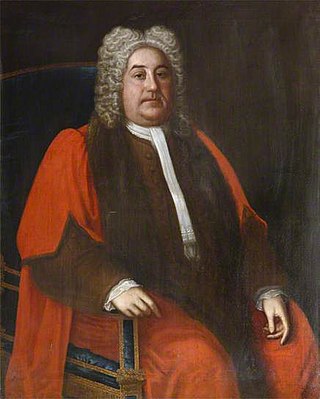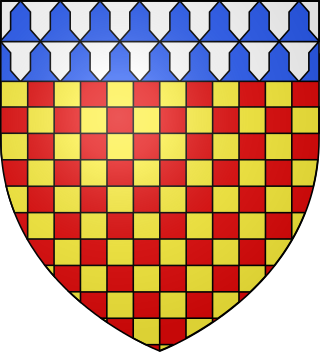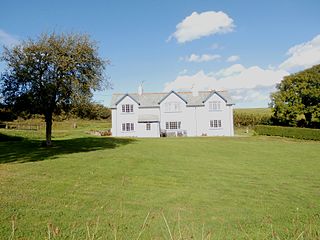This article needs additional citations for verification .(December 2008) |
The Deanery of Barnstaple is part of the Archdeaconry of Barnstaple, one of the four archdeaconries in the Diocese of Exeter.
This article needs additional citations for verification .(December 2008) |
The Deanery of Barnstaple is part of the Archdeaconry of Barnstaple, one of the four archdeaconries in the Diocese of Exeter.
The parishes of the Barnstaple Deanery are: [1]

Barnstaple is a river-port town and civil parish in the North Devon district of Devon, England. The town lies at the River Taw's lowest crossing point before the Bristol Channel. From the 14th century, it was licensed to export wool from which it earned great wealth. Later it imported Irish wool, but its harbour silted up and other trades developed such as shipbuilding, foundries and sawmills. A Victorian market building survives, with a high glass and timber roof on iron columns.

Braunton is a large village, civil parish, ecclesiastical parish and former manor in Devon. The village is situated 5 miles (8 km) west of Barnstaple. It is one of the largest villages in Devon with a population at the 2021 census of 10,217 people. There are two electoral wards. Their joint population at the above census was 8,218. Within the parish is the fertile, low-lying Braunton Great Field, which adjoins the undulating Braunton Burrows, the Core Area in North Devon Biosphere Reserve, the largest psammosere in England. It confronts the Atlantic Ocean at the west of the parish at the large beach of Saunton Sands, one of the South West's international-standard surfing beaches.

The River Taw in England rises at Taw Head, a spring on the central northern flanks of Dartmoor, crosses North Devon and at the town of Barnstaple, formerly a significant port, empties into Bideford Bay in the Bristol Channel, having formed a large estuary of wide meanders which at its western end is the estuary of the River Torridge.

Pilton is a suburb of the town of Barnstaple, it is located about quarter of a mile north of the town centre, in the civil parish of Barnstaple, in the North Devon district, in the county of Devon, England. It was formerly a separate village. The civil parish of Pilton West covers the more rural parts of the ancient parish of Pilton that have not been incorporated into the town of Barnstaple. In 2009, the Pilton (Barnstaple) ward had a population of 4,239 living in some 1,959 dwellings. It has its own infants and junior school, houses one of Barnstaple's larger secondary schools, and one of Barnstaple's SEN specialist schools. North Devon Hospital is also within West Pilton parish. It has a Church Hall, two public houses, two hotels, and residential homes. It has residential estates of both private and public housing including flats. It also has a historic Church that dates back to at least the 11th Century.

Bishop's Tawton is a village and civil parish in the North Devon district of Devon, England. It is in the valley of the River Taw, about three miles south of Barnstaple. According to the 2001 census the parish had a population of 1,176.

The Diocese of Exeter is a Church of England diocese covering the county of Devon. It is one of the largest dioceses in England. The Cathedral Church of St Peter in Exeter is the seat of the diocesan Bishop of Exeter. It is part of the Province of Canterbury. The diocesan bishop is assisted by two suffragan bishops, the Bishop of Crediton and the Bishop of Plymouth. The See of Crediton was created in 1897 and the See of Plymouth in 1923.

Heanton Punchardon ( ) is a village, civil parish and former manor, anciently part of Braunton Hundred. It is situated directly east-southeast of the village of Braunton, in North Devon. The parish lies on the north bank of the estuary of the River Taw and it is surrounded, clockwise from the north, by the parishes of Braunton, Marwood, Ashford and across the estuary, Fremington. The population was 418 in 1801 and 404 in 1901. Its largest localities are Wrafton and Chivenor. The surrounding area is also an electoral ward with a total population at the 2011 census of 2,673.

Benjamin Incledon (1730–1796) of Pilton House, Pilton, near Barnstaple in North Devon, was an English antiquarian and genealogist. He served as Recorder of Barnstaple (1758–1796).
The hundred of Braunton was the name of one of thirty two ancient administrative units of Devon, England.

The historic manor of Raleigh, near Barnstaple and in the parish of Pilton, North Devon, England, was the first recorded home in the 14th century of the influential Chichester family of Devon. It was recorded in Domesday Book of 1086 together with three other manors that lay within the later-created parish of Pilton. The manor lies above the River Yeo on the southern slope of the hill on top of which stand the ruins of the Anglo-Saxon hillfort called Roborough Castle. Part of the historic manor of Raleigh is now the site of the North Devon District Hospital.

Sir John Chichester, 4th Baronet of Youlston Park in the parish of Shirwell near Barnstaple, Devon was a British landowner and Tory politician who sat in the House of Commons from 1734 to 1740.

Hall is a large estate within the parish and former manor of Bishop's Tawton, Devon. It was for several centuries the seat of a younger branch of the prominent and ancient North Devon family of Chichester of Raleigh, near Barnstaple. The mansion house is situated about 2 miles south-east of the village of Bishop's Tawton and 4 miles south-east of Barnstaple, and sits on a south facing slope of the valley of the River Taw, overlooking the river towards the village of Atherington. The house and about 2,500 acres of surrounding land continues today to be owned and occupied by descendants, via a female line, of the Chichester family. The present Grade II* listed neo-Jacobean house was built by Robert Chichester between 1844 and 1847 and replaced an earlier building. Near the house to the south at the crossroads of Herner the Chichester family erected in the 1880s a private chapel of ease which contains mediaeval woodwork saved from the demolished Old Guildhall in Barnstaple.

Incledon in the parish of Braunton, North Devon, England, is an ancient historic estate which gave its name to the locally prominent de Incledon family, first recorded in 1160. It is situated one mile north-west of St Brannock's Church in Braunton. Its relationship to Incledon Hill in the parish of Georgeham, where is situated a modern farmhouse also called Incledon, 1 1/4 miles north-west of Incledon in Braunton, is unclear. In 1319 the Incledon family purchased the adjoining estate of Buckland, and the present Georgian Buckland House, 1/2 mile south-east of Incledon, is still occupied in 2014 by descendants of the Incledon-Webber family.

Robert Incledon (1676–1758) of Pilton House, Pilton, near Barnstaple in North Devon, was a lawyer of New Inn, London, a Clerk of the Peace for Devon, Deputy Recorder of Barnstaple and was twice Mayor of Barnstaple, in 1712 and 1721. In 1713 as mayor he supervised the building of the Mercantile Exchange on Barnstaple Quay, as recorded on the building by a contemporary brass plaque and sculpture of his armorials. He built Pilton House in 1746.

Sir Nicholas II Hooper (1654-1731) of Fullabrook, Braunton and Raleigh, Pilton in Devon, was a lawyer who served as Tory Member of Parliament for Barnstaple 1695-1715.

Rev. Martin Blake (1593-1673) was vicar of Barnstaple in Devon, 1628–56; 1660–73, and suffered much for his adherence to the Royalist cause during the Civil War, as related in John Walker's Sufferings of the Clergy (1714). According to Chanter (1882) "The eventful history of the Rev. Martin Blake has been often written in public history and local annals".